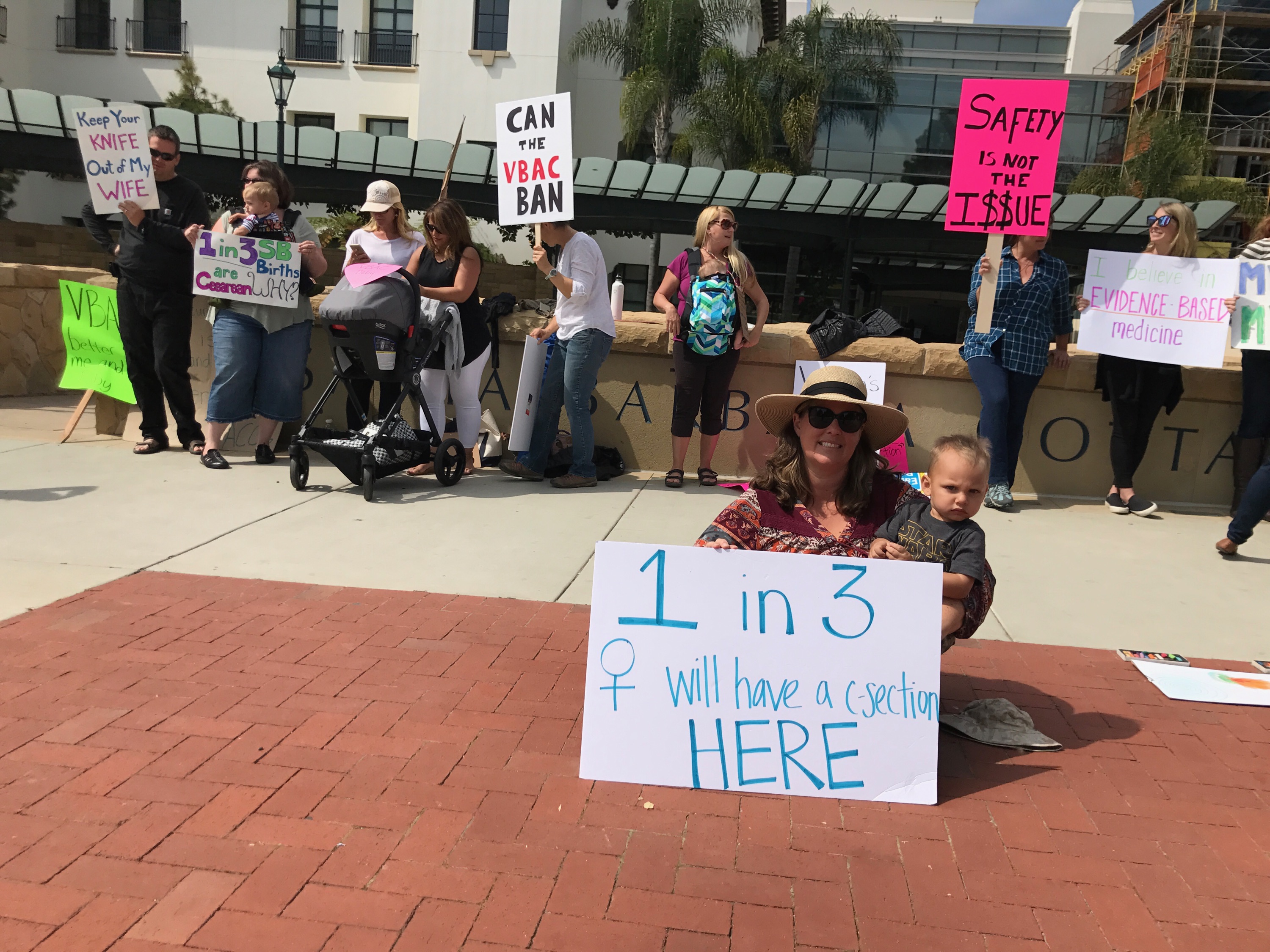
“My body, my choice!” chants echoed outside Cottage Hospital on Saturday afternoon, when mothers, babies, husbands, and midwives gathered to protest the hospital’s VBAC (Vaginal Birth After Cesarean) ban. The ban, established in 2003, prevents women from being offered vaginal birth assistance after having a C-section.
In 2010, the American College of Obstetrics and Gynecology (ACOG) deemed VBAC “a safe and appropriate choice for most women who have had prior cesarean delivery.” This remains the current recommendation, and many southern and central California hospitals have since lifted their VBAC ban, such as the Ventura County Medical Center in 2016. In addition, several hospitals, both small and large, in areas surrounding the county are VBAC friendly. Among these include the UCLA Medical Center, Kaiser Permanente Los Angeles, and Cedars-Sinai Los Angeles.
In a 2014 study, ACOG also expressed “significant concern that cesarean delivery is overused.” They reported a rapid increase in cesarean birth rates from 1996 to 2011, with one in three babies birthed by cesarean delivery. This aligns with statistics at Cottage, where 32 percent of babies are born by C-section, according to Virginia Bobro, area childbirth mentor and educator.
Cottage, though, has upheld their prohibition of VBAC. Cottage spokesperson Maria Zate said the hospital is not currently offering the option “due to the risks and complications and the current physician coverage recommended for maintaining VBAC standby emergency care.”
Protestors claimed the reason for the ban is money. Julia Smart, an area mother of three who had a VBAC following two Cesareans but had to go to UCLA to do so, said Cottage’s policy is motivated by time and money. “Instead of standing up for women’s rights, they use the excuse of trying to save babies. Doctors make an extra $2,500 for cesareans,” she said.
Smart said she was lucky to be able to have her third child naturally at UCLA, given that she had a husband to help, the money to pay for a babysitter, and friends to stay with in L.A. “Many women are forced into surgery because they don’t have the financial means to do that,” she said.
Coincidentally, Smart lives next to an obstetrician-gynecologist, who works at Cottage. When asked why the ban was still in place, he responded that there is no demand for it at Cottage.
Meghan Schoneberger, a mother of one and currently expecting, said pregnant mothers are told at prenatal gynecologic visits that Cottage does not provide VBAC, and thus seek care elsewhere. According to Bobro, “elsewhere” involves driving out of the county or paying for a midwife.
While the ban caused her to consider not having another child because of her reluctance to repeat the emotional and physical trauma of her first C-section, she decided to seek care in Ventura to pursue a natural delivery. This includes “a three hour endeavor for every five minute appointment,” she said. She plans to hop in the car and head to Ventura when she is in labor, as well. She just hopes it won’t be a Friday at 4 p.m.
The hospital told Schoneberger that while they are supportive of VBAC, “it doesn’t make financial sense to do them for 10 moms per year,” she said. Many protestors argued the demand in the county is much greater for these births.
Sarah Manski had her second child at Cottage by C-section last June. “I wanted a VBAC but they told me I couldn’t,” she said. “They said if I wanted to I could go to L.A.” She commented on the emotional factor of this ban. “Every woman is upset when forced into major surgery,” she said.
Zate said hospitals must be equipped with physician specialists available for emergency care of VBAC patients. “Busy L.A. centers with OB/GYN residents have coverage, but we don’t have as many physicians in our community,” she said.
Anastasia Stone, protest coordinator, claimed the hospital cannot legally refuse help to patients who resist cesarean births. However, women are “bullied and coerced” at Cottage into having C-sections, Stone said.
Elizabeth Dark concurred, stating that her “doctor made up statistics” in a conversation with her. “He said to me, ‘what percentage do I have to tell you to make you have a C-section?’ He told me I was going to have to poop in a bag the rest of my life if I went through with a natural birth.”
Dr. Alex Soffici, an obstetrician-gynecologist at Cottage, said in a statement, “For many women, VBAC will have a positive outcome, but for about one in 200, it can result in a potentially fatal uterine rupture that can happen in a matter of minutes.”
C-sections come with their own risks, according to Bobro, who cited allergies, respiratory problems, difficult breast-feeding, weight gain, and weak immune systems as common outcomes for both the baby and the mother. “Neither VBAC nor cesarean birth is always more risky than another — it depends on the individual,” she said.
“We are not advocating for VBACs to be recommended in every case,” Bobro said. “We are advocating for the woman’s choice.”



